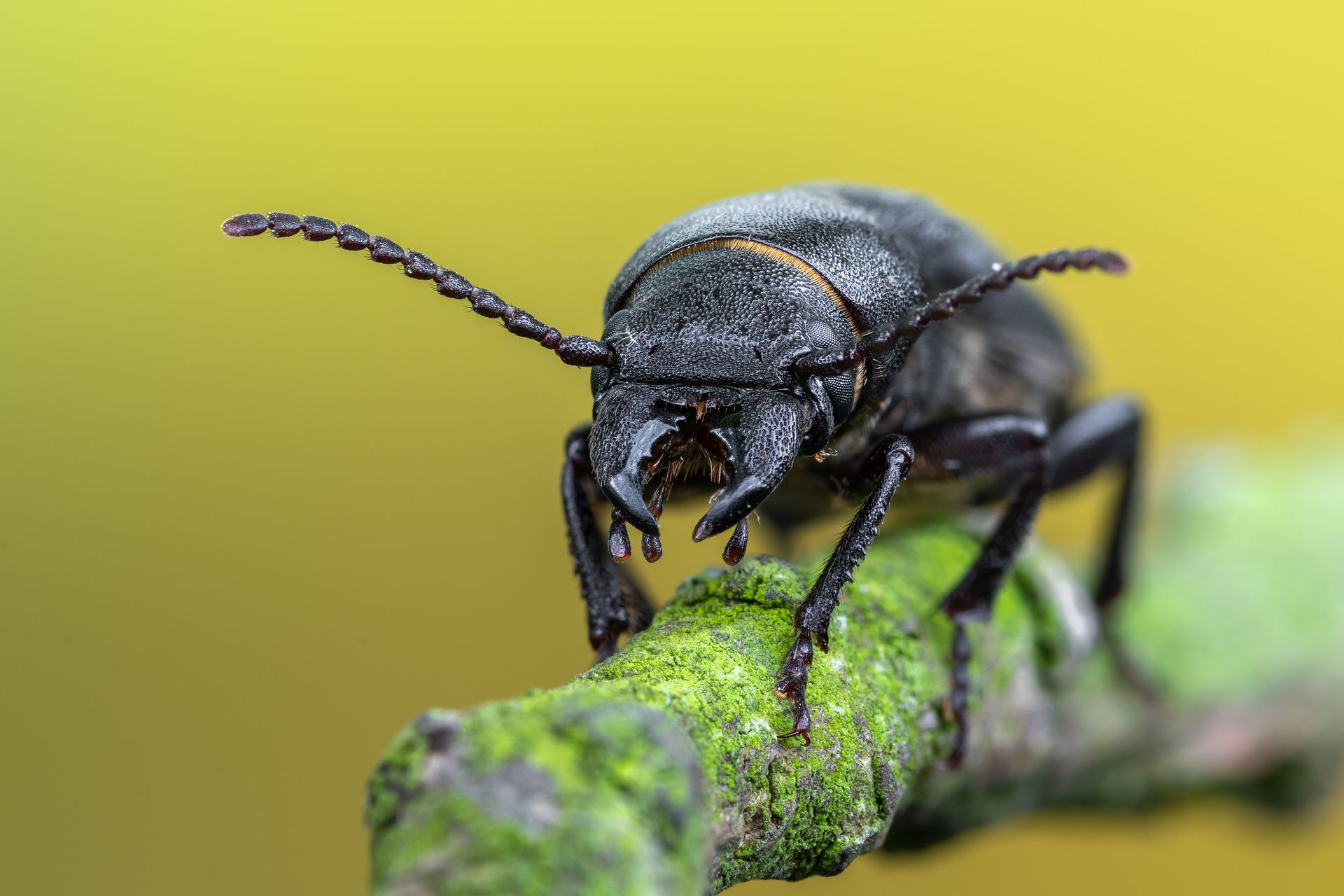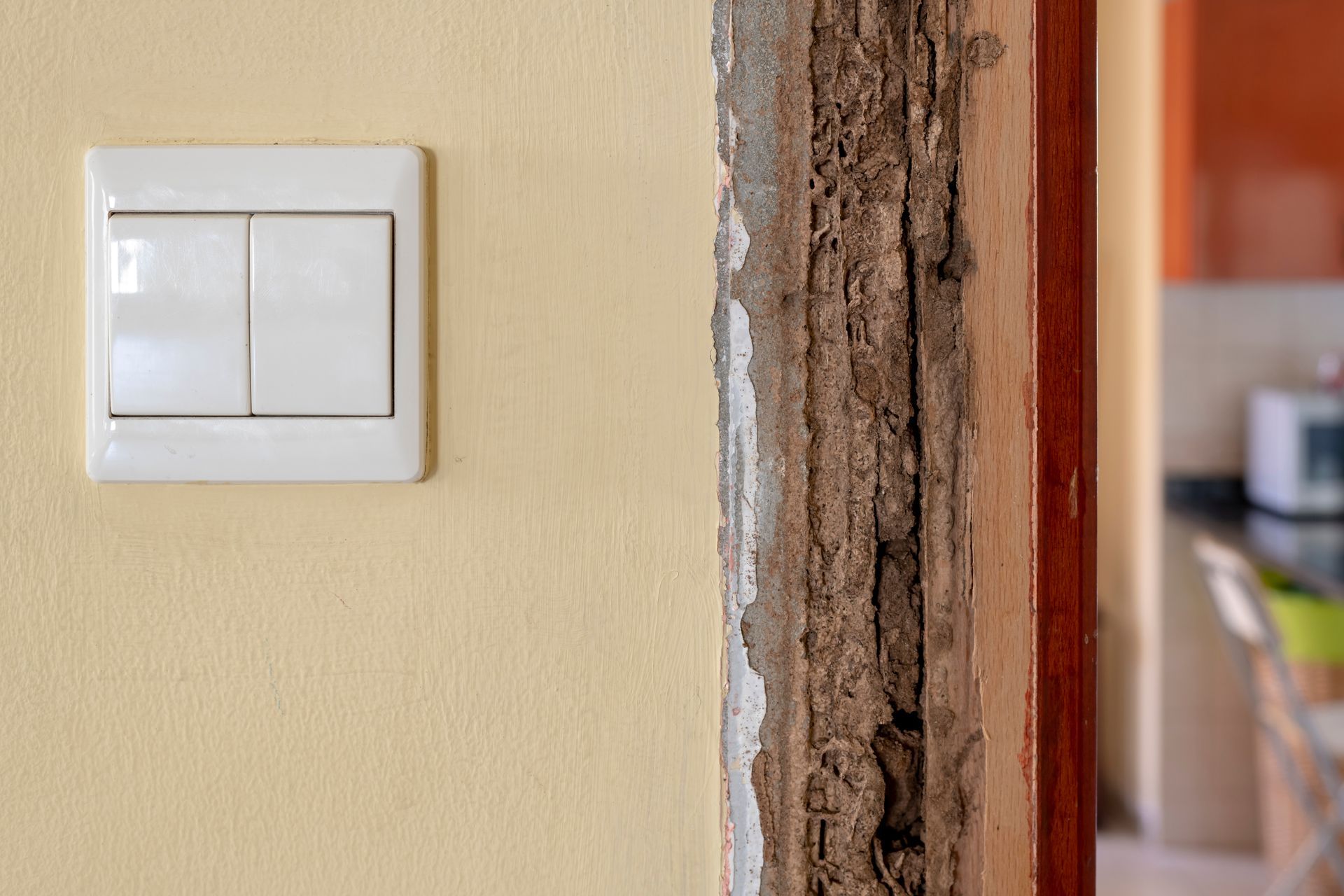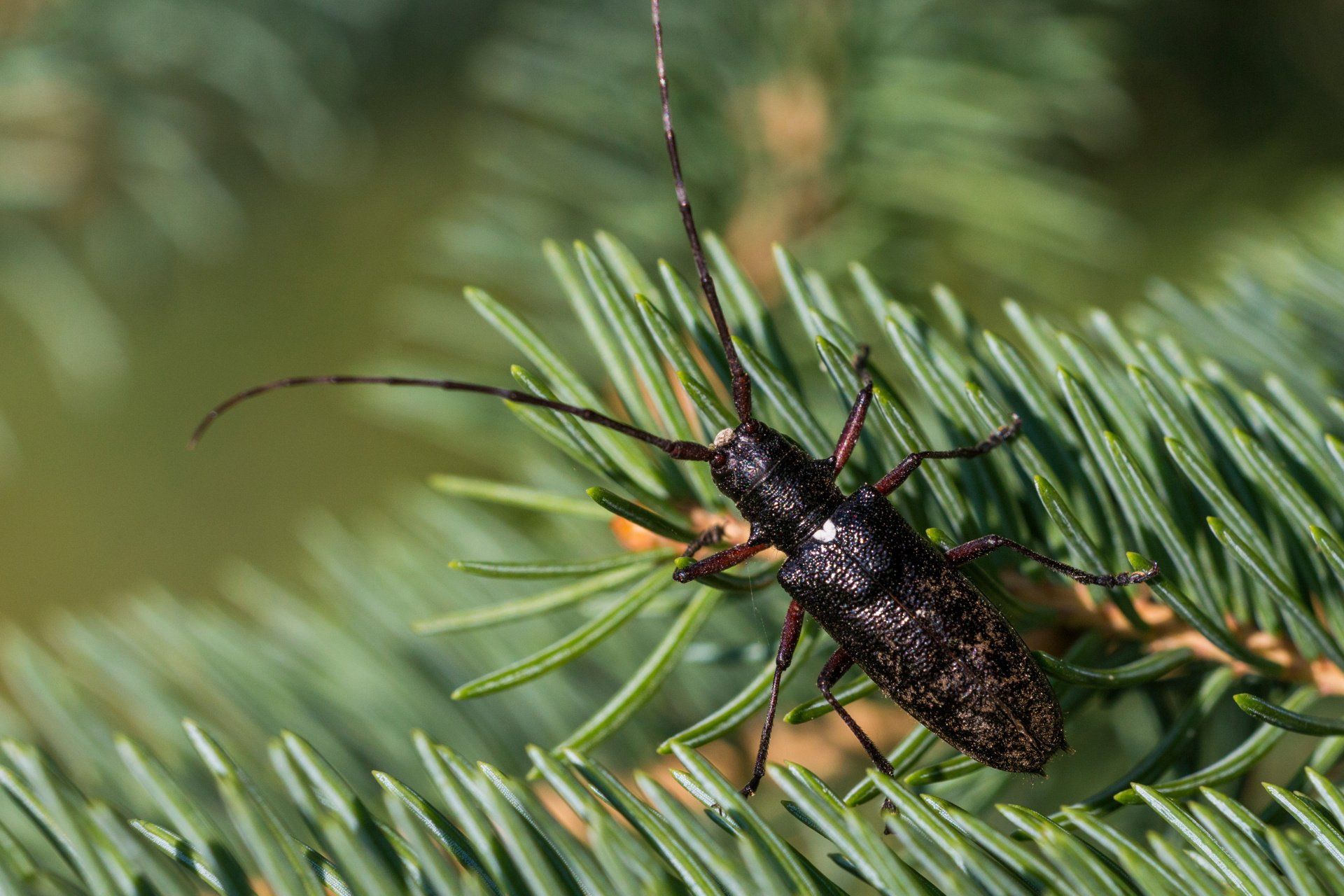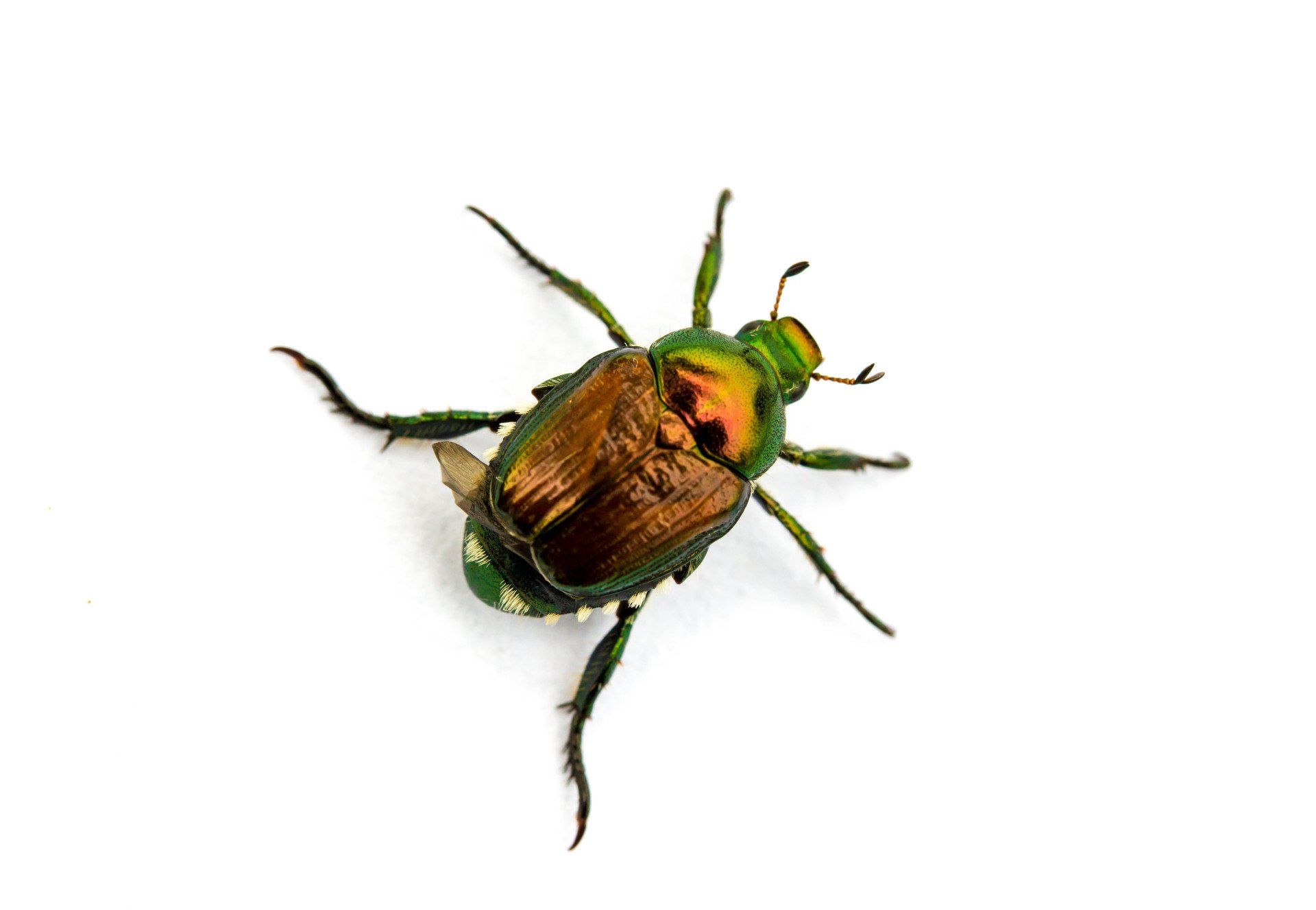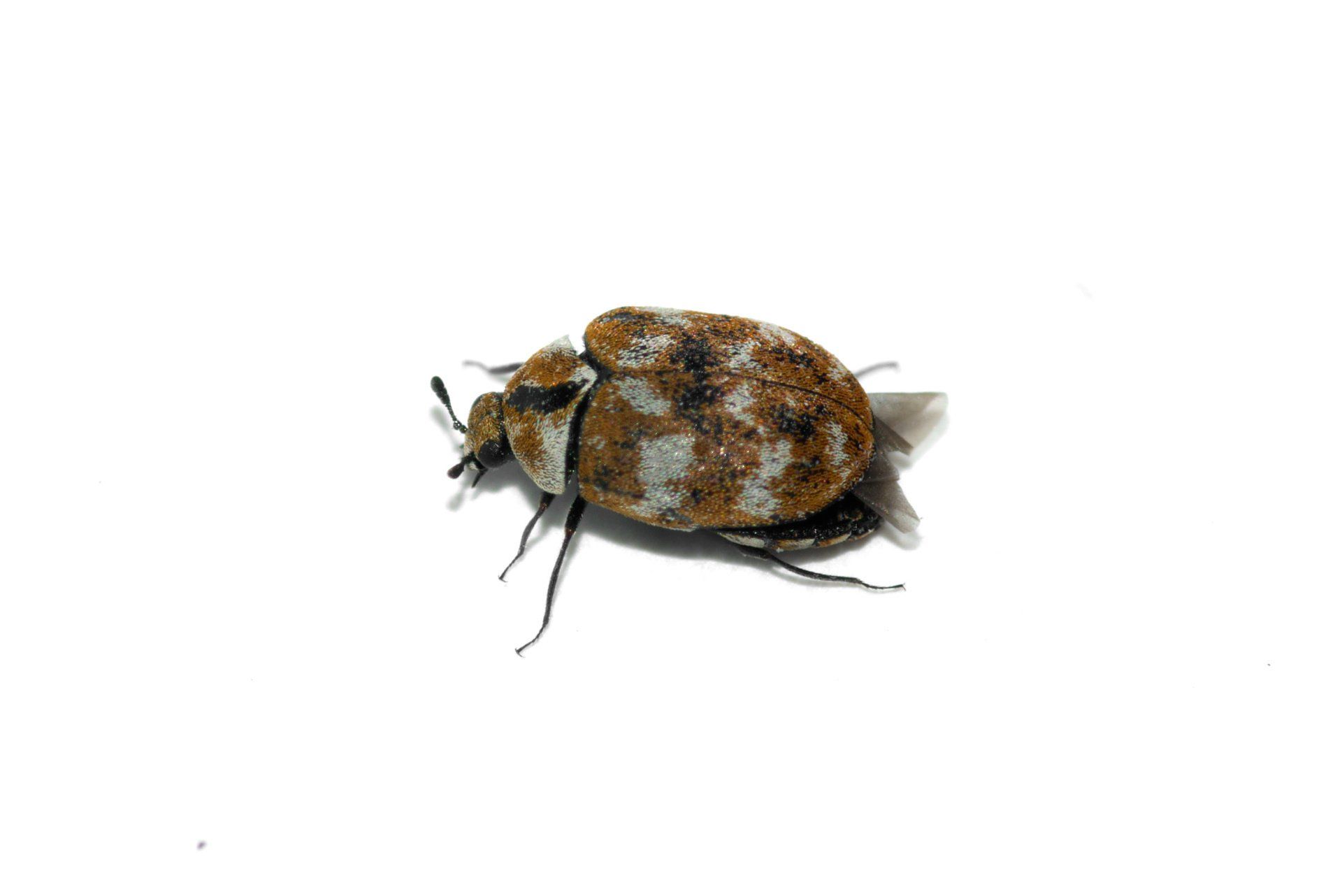Wood Boring Beetle Control and Treatment
The destruction of wood boring beetles occurs silently as they transform cherished heirlooms and critical support beams into honeycomb networks of tunnels and chambers. With larvae feasting unseen for years within wooden structures, the sudden appearance of perfectly circular emergence holes and fine powder beneath wooden elements signals the damage has already progressed far beyond surface level. EcoGuard Pest Management brings decades of specialized entomological expertise to detect infestations in their earliest stages. We employ species specific treatment strategies that penetrate deep within affected wood to eliminate developing beetles while establishing protective barriers that shield your home's wooden assets from future generations of these persistent wood consuming insects.
Call today for a free estimate 866-326-2847
Pest FREE Guarantee
All Natural Services
Licensed & Insured
Competitive Pricing
Professional Wood Boring Beetle Control Experts
Effective wood boring beetle control requires specialized knowledge of these destructive insects' biology, behavior patterns, and lifecycle stages. Our highly trained technicians understand the distinct characteristics of different wood boring beetle species including powderpost, deathwatch, old house borers, and furniture beetles. This allows us to accurately identify the specific pests affecting your property. This expertise enables us to implement targeted treatment strategies that address both active infestations and the environmental conditions that attract these wood destroying insects.
What Problems Do Wood Boring Beetles Cause?
EcoGuard Pest Management is a leader in wood boring beetle control methodology & service.
Wood boring beetles create unique challenges that demand professional attention:
- These destructive pests operate in complete concealment, with wood boring beetle larvae developing inside wooden materials for 1-12 years depending on species [1]. This extended lifecycle allows extensive internal damage to occur before any visible signs appear.
- Unlike visible pests, wood boring beetles spend most of their lifecycle as larvae hidden within wood. Only when adults emerge through distinctive exit holes does the infestation become apparent which unfortunately occurs after significant damage has already happened.
- Different species target different wood types with some species preferring hardwoods like oak, maple, and walnut, while others attack softwoods like pine and fir. This leaves virtually no wooden structures immune to potential infestation and necessitates species specific identification for effective treatment.
- Wood boring beetle damage compounds over time as new generations continue to infest and reinfest the same wooden elements. This creates extensive gallery systems that weaken structural components and furnishings to the point where complete replacement may be necessary.
How EcoGuard Gets Rid of Wood Boring Beetles
Our comprehensive approach to wood boring beetle control combines multiple strategies tailored to your specific infestation:
- Residual Borate Treatments: Professional grade borate applications that penetrate deep into wood fibers to eliminate existing larvae while creating long lasting protection against future infestations.
- Targeted Gallery Injections: Precision application of specialized insecticides directly into beetle galleries and exit holes to reach and eliminate developing larvae.
- Surface Spray Treatments: Residual insecticide applications to exposed wood surfaces that provide both immediate control of emerging adults and preventive protection against new egg laying activity.
- Heat Treatments: Controlled thermal remediation that raises the core temperature of infested wood to levels lethal to all life stages of wood boring beetles without chemical applications.
- Dust Applications: Strategic placement of specialized insecticidal dusts or diatomaceous earth into wall voids, attic spaces, and inaccessible areas to provide long lasting protection as the fine particles coat surfaces and remain effective against adult beetles.
- Fumigation Services: For severe or widespread infestations, whole structure fumigation using professional grade fumigants that penetrate all wood elements to eliminate every life stage of the infestation throughout the entire structure
Wood Boring Beetle Species
Understanding the specific wood boring beetle affecting your property is crucial for effective treatment, as different species target distinct wood types and require specialized control approaches:
- Powderpost Beetles (Lyctidae Family): These small (1/8-1/4 inch) reddish brown to black beetles primarily attack hardwoods with large pores like oak, ash, and hickory. They create pinhead sized exit holes and produce extremely fine, flour like frass. Powderpost beetles typically infest newer wood with high starch content and can reduce structural timbers and furniture to powder from the inside out.
- Anobiid Beetles (Deathwatch Beetles): Slightly larger than powderpost beetles and brown to chocolate in color, these pests attack both hardwoods and softwoods. They create pellet shaped frass and favor damp, poorly ventilated areas like crawl spaces.
- Old House Borers (Cerambycidae Family): Despite their name, these beetles commonly infest newer homes, targeting softwoods like pine used in structural framing. They create oval shaped exit holes (1/4-3/8 inch) and leave coarse, gritty frass containing barrel shaped pellets. Their lengthy development period (3-12 years) means damage often remains hidden for years after construction.
- False Powderpost Beetles (Bostrichidae Family): These stout bodied beetles attack hardwoods and bamboo, creating larger exit holes than true powderpost beetles. Their frass is meal like and tightly packed in galleries.
- Flatheaded Borers (Buprestidae Family): These metallic colored beetles primarily attack weakened, stressed, or dying trees but can occasionally infest lumber. Their larvae create distinctive oval shaped tunnels that are flattened and packed with frass. They typically complete their lifecycle before wood is processed but can sometimes emerge from finished lumber.
- Roundheaded Borers (Cerambycidae Family): Often brought into homes through firewood or newly processed lumber, these beetles create round to oval galleries packed with fibrous frass. Most species cannot reinfest seasoned wood and emerge within 1-2 years after wood processing.
What Attracts Wood Boring Beetles
Understanding what draws wood boring beetles to your property is essential for effective control:
- High Moisture Content: Most wood boring beetle species require wood with 13-30% moisture content for larval development [2], making properties with poor ventilation, plumbing leaks, or inadequate drainage particularly susceptible to infestation.
- Untreated Wood Surfaces: Raw, unfinished wood without protective sealants like paint, varnish, or polyurethane provides ideal egg laying sites for female beetles, especially in older homes with extensive exposed wooden elements.
- Previous Infestations: Many species of wood boring beetles, particularly powderpost beetles, tend to reinfest the same wooden materials, with females preferentially laying eggs in wood from which they emerged.
- Wood Type and Age: Different beetle species target specific wood types with some preferring hardwoods with large pores (oak, ash), while others favor softwoods (pine) or partially decayed wood.
How to Prevent Wood Boring Beetles
Protecting your property from wood boring beetle infestations requires a proactive approach that addresses both existing vulnerabilities and potential entry routes:
- Maintain Proper Wood Moisture Levels: Keep indoor humidity below 55% using dehumidifiers in susceptible areas like basements, crawlspaces, and attics. Install proper ventilation in these spaces and repair plumbing leaks promptly, as most wood boring beetles require specific moisture conditions to successfully develop.
- Inspect Wood Before Purchase: Carefully examine lumber, furniture, and wooden decorative items before bringing them into your home. Look for small holes, sawdust, or tunneling that might indicate beetle presence. Pay particular attention to antiques, imported wood products, and reclaimed lumber.
- Apply Protective Finishes: Seal exposed wood surfaces with paint, varnish, polyurethane, or other appropriate finishes to eliminate access to pores and cracks where female beetles lay eggs.
- Heat Treatment for New Materials: When possible, ensure new lumber has been properly kiln dried to core temperatures sufficient to kill beetle eggs and larvae (140°F or higher for several hours) [3]. For smaller wooden items, professional heat chamber treatments can eliminate all life stages of beetles.
- Regular Professional Inspections: Schedule annual wood destroying organism inspections that specifically include wood boring beetle assessment. Professional inspectors can identify early signs of infestation and vulnerable conditions before significant damage occurs.
- Proper Wood Storage Practices: Store firewood and lumber away from the home's foundation, elevated off the ground, and covered to protect from moisture. Use and rotate firewood promptly rather than storing it for extended periods and inspect it carefully before bringing indoors.
Signs of a Wood Boring Beetle Infestation
Watch for these distinctive indicators of wood boring beetle activity:
- Exit Holes in Wood: Small, round holes ranging from 1/16 to 3/8 inch in diameter that appear in wooden surfaces, indicating where adult beetles have emerged after completing their development.
- Powdery Frass (Insect Waste): Fine, flour like powder or pellet shaped droppings pushed out of galleries by feeding larvae. This often accumulates on surfaces below infested wood or falling from exit holes when disturbed.
- Weakened Structural Wood: Previously solid wood that sounds hollow when tapped or feels softer than surrounding areas, indicating internal tunneling and gallery formation by beetle larvae.
- Active Adult Beetles: Presence of small beetles (1/8 to 3/4 inch long depending on species) near wooden surfaces, windows, or light sources, particularly noticeable during spring and summer emergence periods.
- Audible Ticking Sounds: In the case of deathwatch beetles, distinctive tapping or clicking noises produced by adult beetles during mating season which are typically heard in quiet environments at night.
- Failed Structural Elements: Sagging floors, cracking joists, or weakened support beams resulting from extensive internal wood damage that has compromised the structural integrity of wooden components.
DIY vs Professional Treatment
While hardware stores offer various wood boring beetle control products, DIY approaches rarely provide effective elimination of these persistent pests. Consumer grade surface treatments fail to penetrate deeply enough to reach larvae already developing within wood, and without proper identification of the specific beetle species, inappropriate treatment methods may be applied. Additionally, many effective wood preserving chemicals are only available to licensed professionals, limiting the options for homeowners attempting self-treatment.
Our technicians possess specialized knowledge to accurately identify beetle species based on exit hole size, frass characteristics, and wood preferences, ensuring the correct treatment approach is implemented. We utilize commercial grade products that penetrate deeply into wood fibers, reaching developing larvae where DIY products cannot. Furthermore, our integrated approach addresses both active infestations and the environmental conditions promoting beetle activity, providing long term protection while preserving the integrity and value of your wooden structures and furnishings.
Commercial Wood Boring Beetle Control
EcoGuard Pest Management delivers specialized wood boring beetle control programs for businesses facing structural damage risks and property preservation concerns. Our commercial services address the unique challenges these pests present in different business environments through customized treatment protocols.
We provide expert wood boring beetle control solutions for:
- Hotels and Resorts
- Historic Buildings and Museums
- Furniture Manufacturers
- Woodworking Shops
- Lumber Storage Facilities
- Antique Dealers
- Construction Companies
- Log Home Builders
- Furniture Restoration Businesses
- Timber Frame Structures
For immediate service for all of your beetle control concerns please call 866-326-2847 or complete this form.
EcoGuard Guarantee
We understand the persistent threat wood boring beetles pose to your property and back our control services with a comprehensive guarantee. If beetles remain active in treated areas during your service period, our technicians will promptly return to reassess and retreat at no additional cost. Our commitment extends beyond initial control to ensure lasting protection through thorough follow up inspections, monitoring of treated areas, and rapid response to any signs of continued or new beetle activity.
Wood Boring Beetle Control Process
Inspection: Our technicians conduct a thorough property examination focusing on all wooden structures and elements to identify active wood boring beetle infestations and determine the specific species involved. This comprehensive assessment documents damage patterns, identifies active versus inactive infestations through fresh frass analysis, and evaluates moisture conditions that may be contributing to beetle development.
Treatment: Based on inspection findings, we implement targeted applications using the appropriate combination of professional grade products for the identified beetle species. Treatments may include borate solutions that penetrate wood fibers, direct gallery injections for active infestations, surface treatments for preventive control, or more extensive measures like fumigation when warranted by infestation severity.
Exclusion: After treatment, we address environmental factors that contribute to wood boring beetle problems, focusing particularly on moisture management through improved ventilation recommendations, identification of water intrusion sources, and guidance on protective sealants for vulnerable wood surfaces to prevent future infestations.
Ongoing Monitoring: Regular follow up inspections allow us to track treatment effectiveness and identify any signs of continued beetle activity before significant new damage can occur. Our monitoring program includes assessment of wood moisture content levels and evaluation of previously treated areas to ensure complete elimination of all developmental stages.
Seasonal Plan for Wood Boring Beetle Control
Spring - Critical vigilance period as warming temperatures trigger adult beetle emergence and mating activity. We focus on thorough property inspections to identify new exit holes and fresh frass while applying preventive treatments to vulnerable wood surfaces before the peak egg laying season begins and adult beetles initiate new infestation cycles.
Summer - Intensive treatment phase targeting both active larvae within wood and newly emerging adults. Summer treatments address the most active feeding and development period for larvae when higher temperatures accelerate their growth and wood consumption, while also preventing newly emerged adults from establishing additional infestations.
Fall - Prevention focus as adult beetle activity diminishes and property preparations for cooler months begin. We concentrate on moisture management strategies, crawlspace and attic inspections, and implementation of preventive treatments to wooden elements that may become attractive to overwintering beetles or be susceptible to spring infestations.
Winter - Assessment period for indoor wooden elements and structural components. Though beetle activity slows during colder months, our winter services include interior inspections of wooden furniture, structural supports, and decorative elements that maintain appropriate temperatures for continued larval development despite outdoor conditions.
Wood Boring Beetle Control FAQs
What are the most common wood boring species found in homes?
Several species commonly infest residential structures, including powderpost beetles (Lyctidae family), deathwatch beetles (Anobiidae family), old house borers (Cerambycidae family), and furniture beetles (Anobiidae family). Each species has distinctive characteristics, damage patterns, and treatment requirements.
How can I tell if I have an active wood boring beetle infestation versus old damage?
Active infestations typically show signs of fresh, light colored frass (resembling sawdust or powder) around or below exit holes. This frass will be the color of fresh cut wood and may continue to accumulate after being cleaned away. You might also observe adult beetles near windows or light sources during emergence seasons, or hear feeding sounds within the wood. In contrast, old damage features dark colored frass, no new accumulation after cleaning, and exit holes that may appear weathered or discolored.
How long does it take wood boring beetles to cause serious structural damage?
The timeline varies significantly based on beetle species, infestation size, and environmental conditions. Powderpost beetles might cause noticeable damage within 1-5 years, while old house borers can take 3-12 years to complete development and emerge as adults. The concealed nature of damage means significant structural compromise often occurs before visible signs appear, with severe infestations potentially requiring structural reinforcement or replacement after multiple generations have developed within the same wooden elements.
What wood types are most vulnerable to wood boring beetle attack?
Vulnerability depends on beetle species:
- Powderpost beetles primarily attack hardwoods with large pores like oak, ash, hickory, and walnut
- Deathwatch beetles prefer softwoods like pine that have begun to decay, especially in damp environments
- Old house borers almost exclusively infest pine and other softwoods used in structural framing
- Furniture beetles attack both hardwoods and softwoods, particularly in older furnishings.
Can wood boring beetles spread from infested wood to other wooden items in my home?
Wood boring beetles can spread throughout a structure once established. After emerging as adults, females seek appropriate wood surfaces for egg laying, potentially infesting previously unaffected items. This cross infestation risk is particularly high with powderpost beetles, which can fly considerable distances within a home to locate suitable egg laying sites. Items sharing storage space with infested wood are at highest risk, making prompt professional treatment essential to prevent spreading.
How do borate treatments work against wood boring beetles?
Borate treatments penetrate wood fibers and remain active for many years and provide both elimination and prevention benefits. When larvae consume treated wood, the borates disrupt their digestive systems which prevent them from processing cellulose and causing mortality. Additionally, these treatments create a protective barrier that prevents newly hatched larvae from successfully developing, even if adult beetles lay eggs on treated surfaces. Professional grade borate applications penetrate more deeply than consumer products which reaches larvae hidden deep within wooden structures.
How safe are wood boring treatments for families and pets?
When properly applied by licensed professionals, modern wood boring beetle treatments pose minimal risk to household members. Today's formulations are designed with safety in mind, with many borate products derived from naturally occurring minerals. Our technicians follow strict application protocols that minimize exposure risk, providing detailed guidance on any temporary access restrictions following treatment. Most residual products become integrated into the wood fibers to create long term protection without ongoing exposure concerns.
How effective is heat treatment for eliminating wood boring beetles?
Heat treatment is highly effective when properly conducted, achieving 100% mortality of all life stages when the core wood temperature reaches 130°F (55°C) for at least 30 minutes. This method is particularly valuable for furniture, art objects, and isolated wooden elements that can be placed in heating chambers or treated with directed heat systems. The primary advantage is its chemical free nature, though heat treatment doesn't provide residual protection against reinfestation, making it most effective when combined with preventive measures.
Will painting or varnishing wood prevent wood boring beetle infestations?
Properly applied surface finishes like paint, varnish, polyurethane, or wax can significantly reduce infestation risk by sealing the small cracks and pores female beetles use for egg laying. However, these treatments only protect the finished surfaces but if there are any existing eggs or larvae already within the wood, they will continue developing despite surface treatments. Additionally, unsealed areas like the bottom of furniture, back sides of molding, or undersides of structural elements remain vulnerable if left untreated, making comprehensive professional treatment advisable even for finished wood.
What steps should I take if I find what looks like wood boring beetle damage?
If you discover suspected beetle damage, first determine if the infestation is active by cleaning away existing frass and monitoring for fresh accumulation. Identify the affected wood types and location patterns to help determine the beetle species involved. Avoid disturbing the wood extensively, as this can destroy evidence professional technicians need for accurate identification. Contact a professional pest control service with wood destroying organism expertise for proper inspection, as effective treatment strategies vary significantly based on the specific beetle species and infestation characteristics.
How do you determine which treatment method is appropriate for my specific situation?
Our treatment recommendations are based on several factors identified during professional inspection: the specific beetle species involved (determined by exit hole size, frass characteristics, and wood type), the extent and location of the infestation, whether it's active or inactive, the function and value of infested materials, and environmental factors like moisture levels and building construction. This comprehensive assessment ensures the selected treatment approach appropriately addresses your specific situation while minimizing unnecessary treatment of unaffected areas.
Can wood boring beetles damage pressure treated lumber?
Most wood boring beetles are deterred by the chemicals in properly pressure treated lumber, particularly materials rated for ground contact. However, as these treatments weather and age, their effectiveness may diminish. Certain species like old house borers can occasionally infest pressure treated softwoods, especially if the treatment was insufficient or if the wood has high moisture content. Professional inspection can determine if pressure treated elements show signs of infestation and recommend appropriate protective measures.
What moisture levels in wood contribute to wood boring beetle problems?
Wood boring beetle larval development varies by species but typically requires moisture content between 15-30%. Deathwatch beetles typically require higher moisture levels (over 16%) and often infest wood affected by fungal decay. Maintaining indoor wood moisture below 12% through proper ventilation, dehumidification, and addressing water intrusion sources creates unfavorable conditions for beetle development and represents an important component of integrated management programs.
How long do professional treatments last against wood boring beetles?
Treatment longevity varies by method and environmental conditions. Professional grade borate treatments typically provide protection for 10+ years when properly applied and as long as the wood remains dry, as these products become integrated into the wood fibers. Surface residual treatments generally offer 1-2 years of protection against new infestations. Preventive measures like moisture management and wood sealing provide ongoing protection when maintained. Most professional companies offer renewable protection programs with regular inspections to ensure continued effectiveness.
What's the difference between powderpost beetles and other wood boring beetles?
Powderpost beetles (Lyctidae family) produce extremely fine, flour like frass and create tiny exit holes (1/16-1/8 inch) and primarily attack hardwoods with visible pores. Deathwatch beetles (Anobiidae) create pellet like frass and slightly larger exit holes, preferring partially decayed, moist softwoods. Old house borers (Cerambycidae) create oval exit holes up to 3/8 inch with coarse, fibrous frass, primarily in pine framing. These distinctions in exit hole size, frass texture, and wood preference are critical for proper identification and treatment selection.
Can wood boring beetles damage engineered wood products like plywood or OSB?
These materials are still subject to wood boring beetle activity but susceptibility varies by product and beetle species. Plywood can be attacked by various wood boring beetles, though the glues and manufacturing processes in modern products provide some resistance. Oriented strand board (OSB) is generally less susceptible due to its processing and resin content. Particleboard and MDF are rarely attacked unless exposed to moisture that breaks down their binding resins. Professional inspection can determine if engineered wood components show evidence of infestation and recommend appropriate treatment approaches.
Will furniture removal be necessary during professional treatment?
For localized infestations in specific furniture pieces, those items might be treated individually without disrupting the entire home. For structural infestations requiring more extensive treatment, some furniture relocation may be necessary to access affected areas. If fumigation is required for severe infestations, temporary removal of all occupants, pets, and certain sensitive items is necessary. Our technicians provide detailed preparation guidelines specific to your treatment plan.
How do you prevent wood boring beetles from returning after treatment?
Reinfestation prevention strategies include maintaining wood moisture content below 12% through proper ventilation and dehumidification, applying protective wood sealants to vulnerable surfaces, implementing regular inspection programs to catch new activity early, promptly addressing water intrusion issues that create favorable moisture conditions, using beetle resistant materials in repairs or renovations, and careful inspection of any wood items before bringing them into your home.
Are wood boring beetles more common in certain regions or climates?
Wood boring beetle prevalence varies geographically. Powderpost beetles are typically found in humid southern regions. Deathwatch beetles favor coastal areas with higher humidity. Old house borers are nationwide but are more prevalent in eastern states.
What makes professional wood boring beetle control more effective than DIY methods?
Professional control offers several advantages: access to restricted use pesticides with greater efficacy and penetration capabilities, specialized application equipment that delivers treatments deep into wood where larvae develop, expertise in correctly identifying beetle species, ability to distinguish between active and inactive infestations to prevent unnecessary treatments, comprehensive understanding of building construction to locate and treat hidden infestations, and integrated management approaches that address both the beetles and the environmental conditions supporting their development.
Additional Beetle Resources
Additional Pest Commonly Treated
See our Pest Library for a full list of insects we treat for. If you don’t see what you are looking for give us a call. We are always here to help! EcoGuard Pest Management provides eco-friendly services for both residential and commercial properties.
Why Choose EcoGuard?
- A pest free guarantee
- Green & ecofriendly pesticides that are state approved
- Licensed, bonded, and insured services
- Competitive pricing




